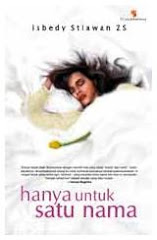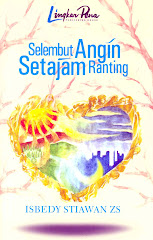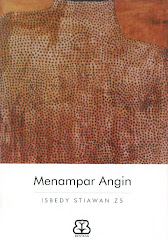for the Poems of Isbedy Stiawan ZS
Sunu Wasono
University of Indonesia
----------------------------------------------------------
Book Title: Kota Cahaya (City of Light)
Author: Isbedy Stiawan ZS
Publisher: Grasindo
Year: 2005
Pages: xiv + 154
---------------------------------------------------------
A poet is never limited or limits himself to a certain theme in his creations. Man’s life and environment provide various problems to be written as poetries. Still, without sharpness and sensitivity, those problems remain simply as they are. They do not become stimuli that move a man to write down his opinions in the form of poetry. That’s the difference between a poet and an ordinary man. Perhaps, in the hand of an ordinary man water dropping from the tap, a clock ticking on the wall or a leaf falling to the ground will be not more than a drop of water, a sound of a clock ticking or a leaf detached from its stalk. Those happenings will be considered as something usual that do not need to be bothered at all. However, with his sensitivity a poet will always observe and question about what lies beneath those physical phenomena; water dropping from the tap, a clock ticking on the wall or a leaf falling to the ground will be read as signs of the presence of death, that is always around. Then, from his hand appear poems about water dropping from the tap, a clock ticking on the wall or a leaf falling to the ground which reflect human consciousness of the coming of death.
A number of Subagio Sastrowardoyo’s and Sapardi Djoko Damono’s poems—for examples—were inspired by such ‘trivial’ phenomena. Of course, this does not only apply to the two poets mentioned. Many other poets also take similar ways to write their poems. What matters now is how far the poet can give meanings to the phenomenon by using language considering that the means of poetry are words. Anything can be written as poetry, however, the value of the poetry is defined by the way language is used to talk about the thing. This does not mean that poetry writing should stop at writing techniques. When a problem is translated into lines of poetry, there will be no clear dichotomy between the form and the content. The theme has become one and is united in a certain way with all the words in the poetry. Finally, the content (theme) and the form of the poetry become the two sides of a coin, one completes the other. This is the principle that bases my analysis of Isbedy Stiawan ZS’ works compiled in Kota Cahaya (City of Light).
The poet stated that the one hundred poems in Kota Cahaya were selected from many other poems he had ever written. This statement implies that the total number of his poems is more than a hundred. It also indicates that there are various themes in Kota Cahaya.
Number relates with productivity. From his statement, it seems that this poet from Lampung is quite productive. He started writing in the 1980s and becomes even more productive lately. The number of poems he has produced and the length of time he has spent in writing them show that he is not a newcomer in poetry writing. It can be said that he has more than enough experience. Does it correlate with maturity? There is no simple answer, of course. However, it is clear that productivity and loyalty—in writing poetry—will open the possibility for the birth of many works with various themes. Kota Cahaya offers a variety of themes that goes along with his being a poet and also a journalist who has to face many kinds of incidents and problems everyday.
The poet divided Kota Cahaya in three parts: Nyanyi Sunyi (Song of Silence/part 1) consisting of 21 poems; Menandai Tahilalat (Marking a Mole/part 2) consisting of 25 poems; and Dari Cerita yang Lain (From Other Stories/part 3) consisting of 54 poems. The division is clearly based on thematic considerations and—mostly—chronology. The dates and years written after each poem indicate that the oldest in Kota Cahaya was written in July 1984 (“Tubuh tanpa Ruh”/Body without Soul) and the youngest in May 2005 (“Hujan: Dari Cerita yang Lain”/Rain: From other Stories). By making such an arrangement, Isbedy seems to show his writing history from time to time. He stated that the poems grouped in part 1 were thematically related with the tendency of the 1980s. Then, religious (sufistic) poetry was the mainstream.
He also stated that his later works had various themes. This went along with his being a journalist who often traveled from one place to another. In his journey, he saw much injustice.
Then he wrote the poems he grouped in part 2. The poems in part 3, he said, showed his maturity, as a man who was almost 50. What he meant was not clear, but he mentioned about maturity. He did not claim that in his being a man three years away from fifty he had reached maturity in writing poetries. He left that judgment fully on the readers’ opinions. However, from his statement in the next part, we get the picture that the poems he wrote lately, in his opinion, showed different characteristics from his earlier ones. He did not relate this change with themes, only styles. He said that in his newer poems he employed short straight sentences (p. xii).
It is true that a poet’s statement can be disregarded when readers want to analyze poetries. However, I do not apply that opinion in reading Isbedy’s poetries in Kota Cahaya. From the poet’s introduction at least we can get a picture that the birth of a poem is not always fully related with the poet’s emotions. It is possible that a poem is influenced by a trend which happens to be in accordance with what the poet feels at the moment. At least this is shown by Isbedy’s statement about the poems he grouped in part 1 of Kota Cahaya. Were his sufistic poetries moved more by the trend of the 1980s or by the restlessness of his soul searching for god? Whatever pushes the birth of a poem, in the end it is how the content of the poem unites with the writing style that counts.
In terms of style, it may be true that Isbedy has gone through changes of writing styles, as he stated. In the poems he wrote in the 2000s, which he placed in part 3, this is clearly shown. As he said, he did not compose his poems in long far-fetching lines and sentences. He preferred to write them in short lines and sentences. However, in my opinion, his poems seem to need many lines and verses. This can be seen in his poems “Di Ambang”, “Kota Cahaya”, or “Sampai Aku Terjaga dan Menemukanmu”. Does this mean that basically Isbedy did not really change his style? I still think he tried to change—not in radical and experimental ways—because, if examined closely, his poems do not try to explain anymore. The many lines used are functional and necessary. It is not only a matter of putting lines in the poems. Isbedy seems to consciously try to make his poems slimmer and more solid.
It is also interesting to note his thematic aspect. Even though Isbedy grouped his poems based on his writing “history” and claimed that he had done some efforts to enrich the themes, especially in the poems he placed in part 2, I still noticed that there was a certain theme that appeared several times in Kota Cahaya. Themes of death, longing and searching (for something lost) appeared in part 1, 2 and 3. Therefore, I can say that the themes of death, longing and searching are the bases of Isbedy’s poems. Though it does not automatically mean that those themes are the dominant ones in this anthology.
In the first part, after “Tubuh Tanpa Ruh” appear some poems with themes of death (“Epitaph”, “Doa Jenazah”, “Aku Hanya Kerak di Liang Bumimu”). Themes of searching can also be found in this part, especially the narrator’s searching for peace. In the poem “Improvisasi II”, for example, the poet wrote about the importance of searching for happiness in smiles and patience.
In the poems placed in the second part, themes of death also appear. In “Ada Daun Gugur” the narrator feels the presence of death by watching the ordinary phenomenon of a leaf falling to the ground. In different ways, “Aku Masih Rasakan”, and “Requiem” also speak about death. The narrator in “Aku Masih Rasakan” who speaks to you tries to remind that I and you (us) will also fall down in the end, like a drop of water on a tree leaf waiting for the “right” moment to fall down. In “Requiem” the narrator tells about the close relationship between life and death. It is said that life and death always repeat themselves. Just like the themes of death, themes of searching and longing also appear in the second part. In “Surat-Surat Cinta” and “Bila Pelayaranku Sampai” the tones of longing appear clearly.
Themes of death are still found in the third part of Kota Cahaya. Though not stated clearly, in “Tak Perlu Teluh”, “Beratuskali Aku Mati”, “Aku Masuki Kolammu”, “Dulu Aku Minta Mati di Laut”, and “Seperti Kematian” death is mentioned. What is described in “Seperti Kematian” is actually a woman; however, the poet describes the mystery of the woman by comparing it with death. The secrecy of the woman’s personality is compared with the mystery of death. Although death only appears as a comparison, its mysterious nature is also discussed here.
There is one more thing which characterizes Isbedy’s poems, i.e. the unity of tone. I did not find tones of humor, jokes, or playfulness in his poems. All has serious tone. Perhaps this was caused by his tendency to be a thinker, so that in his eyes all problems are seen as serious matters, far from humor or playfulness. A poet’s attitude in looking at something is, of course, not our concern. He has the right to choose. And Isbedy, with his chosen attitude, has written a number of poems with a single tone: serious. This kind of poems has found their positions in Indonesian literature. In the end, it is not the tones of humor, jokes or playfulness that matter, it is the poetic means a poet employs to express what he feels, thinks, and suppresses. Kota Cahaya has proven Isbedy a poet with a class and worth mentioning. ***













